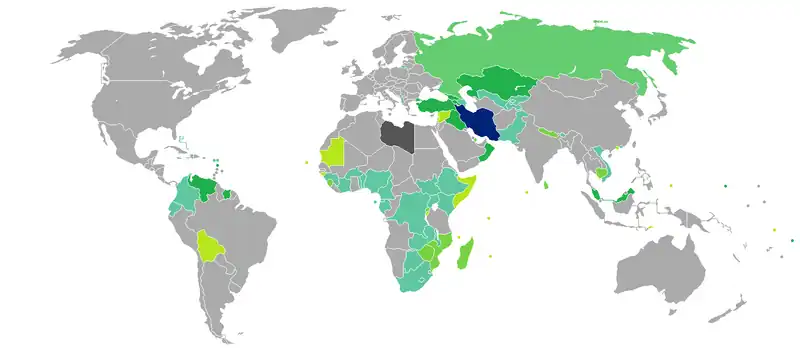Iranian nationality law
Iranian nationality law contains principles of both jus sanguinis and jus soli.
| Iranian Citizenship Act | |
|---|---|
 | |
| Parliament of Iran | |
| |
| Enacted by | Government of Iran |
| Status: Current legislation | |
The full nationality law is defined in Book 2 of the Civil Code of Iran, Articles 976 through 991.[1]
In 2023 a new National immigration organization law granted residency to immigrants and foreigners who invested in Iranian banks or businesses. This was intended to particularly help some Afghan refugees, about five million of whom were in Iran.[2]
Definition of Iranian nationals
Article 976 of the Civil Code of Iran defines who is an Iranian national:[3]
- All residing in Iran except those whose foreign nationality is established; the foreign nationality of such persons is considered to be established if their documents of nationality have not been objected to by the Iranian Government.
- Those born in Iran or outside whose father is Iranian.
- Those born in Iran of unknown parentage.
- People born in Iran of foreign parents, one of whom was also born in Iran.
- People born in Iran of a father of foreign nationality who have resided at least one more year in Iran immediately after reaching the full age of 18; in other cases their naturalization as Iranian subjects will be subject to the stipulations for Iranian naturalization laid down by the law. New legislation passed by the Iranian Parliament in 2012 grants permanent residency to children born to Iranian mothers and foreign fathers.[4]
- Every woman of foreign nationality who marries an Iranian husband.
- Every foreign national who has obtained Iranian nationality.
Citizenship transfer through mother
A new policy allowing Iranian women to pass down their citizenship to their children at birth started to effect from 2020. As of mid-November, about 75,000 people had applied for citizenship under the new law.[5]
Naturalisation
An application for naturalisation as an Iranian must be submitted to either directly to the Ministry of Foreign Affairs, or through the Governors, or the Governors-General and must contain certified copies of identity documents in relation to the applicant and his family (wife and children). certificate certifying period of residence, clean criminal record, sufficient property and employment that ensures a livelihood.[6]
Deprivation of citizenship, dual nationality
Iran does not recognize dual nationality, and considers dual citizens as Iranian citizens only.[7] Nevertheless, article 977 of the Civil Code of Iran deals with multiple citizenship. As a consequence of Paragraphs 4 or 5 of article 976, some Iranian minors may have multiple citizenship. If they wish to retain the non-Iranian nationality after age 18, they have to inform Iran's Ministry of Foreign Affairs.[8]
In theory, voluntary renunciation of Iranian citizenship is possible for persons over the age of 25, subject to approval by the Council of Ministers. However this rarely occurs in practical terms. [9]
Travel freedom

In 2016, Iranian citizens had visa-free or visa on arrival access to 37 countries and territories, ranking the Iranian passport 98th in the world according to the Visa Restrictions Index.
Notes
- UNHCR 2009
- "مجلس اعطای اقامت به اتباع خارجی را بدون تعیین جزئیات تصویب کرد" [The parliament approved the granting of residence to foreign nationals without specifying the details]. Radio Farda. Radio Free Europe. 20 August 2023. Retrieved 20 September 2023.
- UNICEF 2005, p. 6
- "Iran's rules change for children born to foreign fathers". Payvand.com. Retrieved 2020-06-02.
- Berger, Miriam (26 December 2020). "Breaking with some Mideast neighbors, Iran now lets mothers give their citizenship to their children". Washington Post. Retrieved 20 September 2023.
- "Nationality Law | Iran Data Portal". Irandataportal.syr.edu. Retrieved 2020-06-02.
- "Dual Citizenship Iran". Dualcitizenship.com. Retrieved 2020-06-02.
- UNICEF 2005, p. 7
References
- Birth Registration in Iran: An analysis of the state of relevant laws in Iran (PDF), Iran Information Series, UNICEF, 2005, archived from the original (PDF) on 2009-02-28, retrieved 2009-10-20
- Civil Code of Iran (last amended 1985), Refworld, United Nations High Commissioner for Refugees, 2009, retrieved 2009-10-20